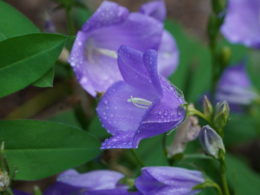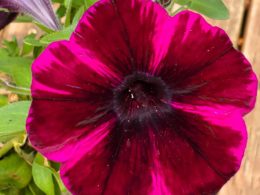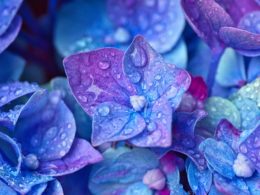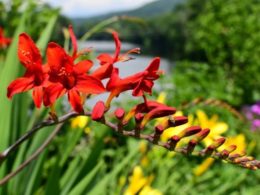Find Out What to Plant with Shasta Daisies – 8 Companion Plants In Your Garden.
Shasta daisies (Chrysanthemum maximum) are a very popular summer-blooming perennial that brighten up any garden space. The question is, what can you pair with them? What plants will complement their shape and mature size?
Luckily, there are many options to choose from depending on your favorite flower colors and designs for your garden.
And with those white petals and yellow centers, Shasta daisies are begging to have other companion plants placed around them. Read on to learn about eight ideas, including some of our favorite plants in our own garden, that would pair well with Shasta’s for a beautiful, summer-blooming garden.
Basic Shasta Daisy Care
In order to prepare for your plantings, it’s a great idea to familiarize yourself with the basic care needs of Shasta daisies. These plant care basics are the foundation from which we built our companion plant list.

- Shasta daisies need full sun
- They flower from late spring and can continue blooming until early fall
- Flower colors come in white petals and yellow center
- They prefer well-draining, nutrient-rich soil
- Their mature, establish height can be 2-4 feet tall
- Their mature width can be 2+feet wide
Companion Plants for Shasta Daisies
Below we have a fun list of eight, great companion plants that would grow well with your Shasta daisies because each plant has similar care needs. Just pick a plant (or two or three) and plant away!
In addition, each plant below varies in height and width to give you design options for using them around, in front, or behind your Shasta daisies.
Campanula, aka Bellflower (Campanula sp.)
- Campanula need full sun to part shade
- Flowers from mid-spring all the way to fall, depending on specific species
- Flowers are light blue or light purple
- Prefers well-draining, nutrient-rich soil
- Best grown on the side or in front of Shasta daisies (from 1 to 6+ feet tall and spreads)
- Perennial
- Plant seeds in spring and transplant larger plants in the fall
If you are looking for Summer Flowering Bulbs to add to your garden, look no further than our latest eBook! 21 Spring-Planted Bulbs For Fantastic Summer Color!
Plan for summer (and maybe early fall) blooms with 60+ pages of summer flowering bulb inspiration! In this colorful, informative guide, get to know 21 summer-flowering bulbs. This guide also explains what bulbs are, defines the 5 different types of bulbs, the correct planting orientation for each of the 5, and much more.
This guide includes these bulbs and more:
- Dahlias
- Tiger lilies
- Gloxinia
- Crocosmia
- Gladiolus
- Tigridia, aka Mexican Shellflower
- And, so many more!
In this guide, 21 spring-planted, summer-flowering bulbs, you’ll learn about each bulb’s care needs like where they will grow, when they flower, different flower colors they are available in, and which online retailers are available for you to purchase your own bulbs. Grab your copy now and start planning your spring and summer flower garden TODAY!
Liatris, aka Blazing Star or Gayfeather (L. spicata)
- Liatris need full sun or light shade in hotter climates
- Flowers during summer months
- Flower colors come in purple, lilac, white, and lavender (sometimes bluish)
- Prefers well-draining medium rich soil
- Best grown on the side or behind (up to 4 feet tall and 1.5 feet wide)
- Perennial bulb
- Plant in spring for summer bloom
Petunia (Petunia sp. and hybrids)
- Petunias need full sun
- Flowers from mid-spring to the end of summer
- Flower colors come in white, cream, yellows, blues, reds, purples, pinks, and in bicolors
- Prefers well-draining, nutrient-rich soil
- Best grown in front of Shasta daisies (grows from 8 inches to 2+ feet high and 1 foot to 4 feet wide)
- Annual in some climates and perennial in others
- Plant mid-spring
Lupine (Lupinus polyphyllus)
- Lupine need full sun
- Flowers from late spring to mid-late summer
- Flower colors come in blue, purple, and red
- Prefers well-draining, nutrient-rich soil
- Best grown on the side or behind Shasta daisies (grows 1.5 to 4 feet tall and 2-2.5 feet wide)
- Perennial
- Sow seeds in fall to early spring; established plants can be transplanted in fall
Gladiolus, aka Garden Gladiolus (G. hybrids)
- Gladiolus need full sun
- Flowers anytime between late spring to the end of summer
- Flower colors come in white, lavender, yellow, orange, apricot, salmon, red, rose, purple, smoky, and even green colored.
- Prefers well-draining, nutrient-rich soil
- Best grown at the side or behind Shasta daisies (grows anywhere between 3 to 6 feet tall
- Plant bulbs in mid to late spring
Hydrangea, aka Big Leaf or Garden Hydrangea (H. macrophylla)
- Hydrangeas need full sun, but partial shade in the warmest climates
- Flowers from the start of summer and can continue through to fall
- Flower colors come in white, pink, red, or blue (soil acidity can affect color)
- Prefers well-draining, nutrient-rich soil
- Best grown behind or to the side of Shasta daisies (grows 4 to 8 feet wide and high)
- Deciduous perennial
- Can be planted in fall, but spring is ok if watered and monitored regularly
Crocosmia, aka Montbretia (C. tritonia or C. x crocosmiiflora)
- Crocosmia needs full sun
- Flowers from the start of summer almost to fall
- Flower colors come in red, yellow, or orange
- Prefers well-draining, nutrient-rich soil
- Best grown beside or behind Shasta daisies (grows 3 to 4 feet tall and 1+ inch wide sword leaves)
- Bulb
- Plant bulbs or seeds in fall for next spring growth and flowers
Garden or Common Sage (Salvia officinalis)
- Sage need full sun
- Flowers from late spring into summer
- Flower colors come in lavender blue, red, violet, pink, and white
- Prefers well-draining, nutrient-rich soil
- Best grown beside or in front of Shasta daisies (grows 1 to 3 feet tall and 1 to 2.5 feet wide)
- Perennial
- Plant in fall
Conclusion
Having common care needs, along with ease of maintenance, Shasta daisies can make your garden exceedingly versatile as a companion to many other plants.
With all the options of these eight plants, and a whole lot more, your Shasta daisies will never get lonely or be without other colors of flowers around them to really accentuate their beauty.
Want to learn about other plants in your garden? Check out some of our previous plant profiles:
- Daffodils: A Gardener’s Guide and Plant Profile
- Shasta Daisy: A Gardener’s Guide and Plant Profile
- Crocosmia: A Gardener’s Guide and Plant Profile
- Primroses: A Gardener’s Guide and Plant Profile
- Tulips: A Gardener’s Guide and Plant Profile
- Grape Hyacinth: A Gardener’s Guide and Plant Profile
- Winter Pansies: A Gardener’s Guide and Plant Profile
See you in the garden!
~ Sean and Allison
P.S. Find us on YouTube, Pinterest, Twitter, Facebook, and Instagram so you don’t miss a thing!
Spokengarden.com is a participant in the Amazon Services LLC Associates Program, an affiliate advertising program designed to provide a means for sites to earn advertising fees by advertising and linking to Amazon.com
Find Out What Companion Plants Shasta Daisies – 8 Companion Plants In Your Garden.
Well, that’s all for now
Find us on













